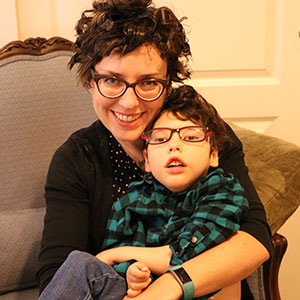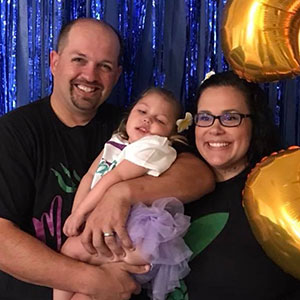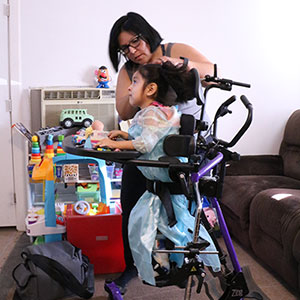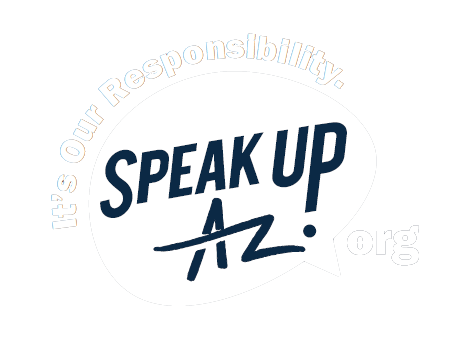Tiny Tykes Make Huge Strides in Learning through Play, Technology and Training
According to the American Academy of Pediatrics, “Play is essential to [child] development because it contributes to the cognitive, physical, social, and emotional well-being of children and youth.” But little ones who lack motor skills find it challenging to reap the benefits of this important learning tool.
“When I have a kiddo who can’t move, they miss out on learning opportunities that their siblings and peers get,” said Melanie Conatser of Advanced Therapy Solutions, a DES Division of Developmental Disabilities (DDD) contracted provider. Conatser, who specializes in working with children who have developmental disabilities and complex medical conditions, offers this example: When a toddler crawls over to the kitchen cabinets, pulls out and stacks the pots and pans, he’s learning. “He learns because he moved over there to get that opportunity,” said Conatser.
Gideon

Kathleen Muldoon snuggles her son, Gideon Dobson.
“Those skills that they learn are really transferrable,” said Kathleen Muldoon. Muldoon knows; her five-year-old son Gideon has cytomegalovirus (CMV). CMV is a common virus that, when contracted during pregnancy, can cause significant brain damage in the developing baby.
Former residents of Vermont, Gideon’s family moved to Arizona shortly after he was born. “I read about ALTCS [Arizona Long Term Care System] and I read about DDD and I read about the Foundation for Blind Children,” said Muldoon. “I saw [Arizona] was ranked #1 for supports for people with disabilities.” For the 6th year, United Cerebral Palsy recognized Arizona as the best in the nation for supporting individuals with developmental disabilities within their Case for Inclusion report. And, unlike Vermont, there is no snow to impede a wheelchair.
Today, Gideon has a new power wheelchair. Because he cannot control his arms or hands, Gideon uses his head, literally, to navigate his power chair. “Two nights ago, he came from his bedroom, turned and [pulled up to the kitchen table]; he did that by himself!” remarked Muldoon. And with his eye gaze-controlled augmentative communications device, which can be mounted to the new power chair, Gideon can have a voice when he’s out in public.
“He doing really, really well with his communication,” said Muldoon. “All because of the supports we’re getting from ALTCS and the services he gets from DDD. We’re giving him a chance to be the best version of him. And he’s doing great!”
Sophia

Sophia Isler celebrates her third birthday with dad, John, and mom, Bianca.
Like Gideon, Sophia Isler was born with CMV. Formerly a member of the Arizona Early Intervention Program (AzEIP), three-year-old Sophia relies on services and supports provided by DDD. To help her move, Sophia began occupational and physical therapies in 2018. She has learned how to use an augmentative communications device and how to operate a power wheelchair. Sophia’s mom, Bianca, extolled how the therapy “gives children the opportunity who don’t have the typical [motor skills] to walk, to use their hands--things like that.” Technology and the training that goes with it gives kids with medically complex bodies the opportunity to explore their surroundings on their own, and exploring their surroundings is an opportunity to learn. “She loves movement,” said Bianca, “and she’s definitely a daredevil.”
“My daughter uses her head to go [forward] and turn.” Sophia is able to turn her head left to scan, then turn right to select words on her iPad, which speaks for her. “It’s the same for her wheel chair,” said Bianca. She turns her head left to press a switch to make the power chair move forward. When her head presses the switch on the right, the chair turns.
Learn more about Sophia’s journey on Facebook.
Harmony

Harmony Brown in her “stander” with mom, Alina Antone, tending to her pigtails.
Harmony Brown has spinal muscular atrophy (SMA), a genetic disease that affects the part of the nervous system that controls voluntary muscle movement. She uses a thoracic lumbar sacral orthosis (TLSO) to help her stand up, a power wheelchair to help her move around and an augmentative communications device to help her communicate, which the family refers to has “her voice.”
“Before treatment [with a new medication], SMA took her voice, her ability to hold her head up, to sit, to eat by mouth, to move and kick her arms and legs,” explained Alina Antone, Harmony’s mom. “But now she’s driving her power wheelchair, she’s standing, and with feeding therapy, she’s now drinking water and trying to relearn how to eat.”
Today, Harmony can move her arms, sway left to right, and stretch to touch her toes. For fun and learning, Harmony joins her brother and sister on Saturday nights as they follow along to a dance video. While her siblings can swing around and jump, Harmony, supported by her stander, sways her body and waves her arms to the beat. She also joins her mother at a weekly Zumba class. “She’s actually learning how to follow along,” said Antone.
To help with her speech, Harmony uses an augmentative communications device. Her communications device came in handy when Harmony’s new leg and foot braces were being adjusted. With “her voice,” Harmony was able to communicate which leg was in pain and where it was hurting. With her assisted mobility and speech, Harmony is more sociable. Not only does she go to school, Harmony is “Miss Popular,” boasted Antone. She also is an ambassador for the Southwest Human Development “Walk with Me” campaign.
Highly motivated and eager to learn, Harmony “really pushes herself, especially in therapies,” said Antone. “She loves [working on her] fine motor activities and learning. She’ll sit and start a task and keep doing it over and over until she tries to get the hang of it.”
Learn more about Harmony’s journey on Facebook.
As an occupational therapist, “I’m pretty passionate about getting my kids moving in any possible way,” said Conatser.
Muldoon supports that passion. “It’s not just about moving [although] moving allows them to be more social, more age appropriate and allows them to make more gains,” said Muldoon. Adaptive technology and occupational therapy make it possible for individuals with developmental disabilities to be more inclusive with family, friends and the community. “It’s really kind of cool!” exclaimed Muldoon.

